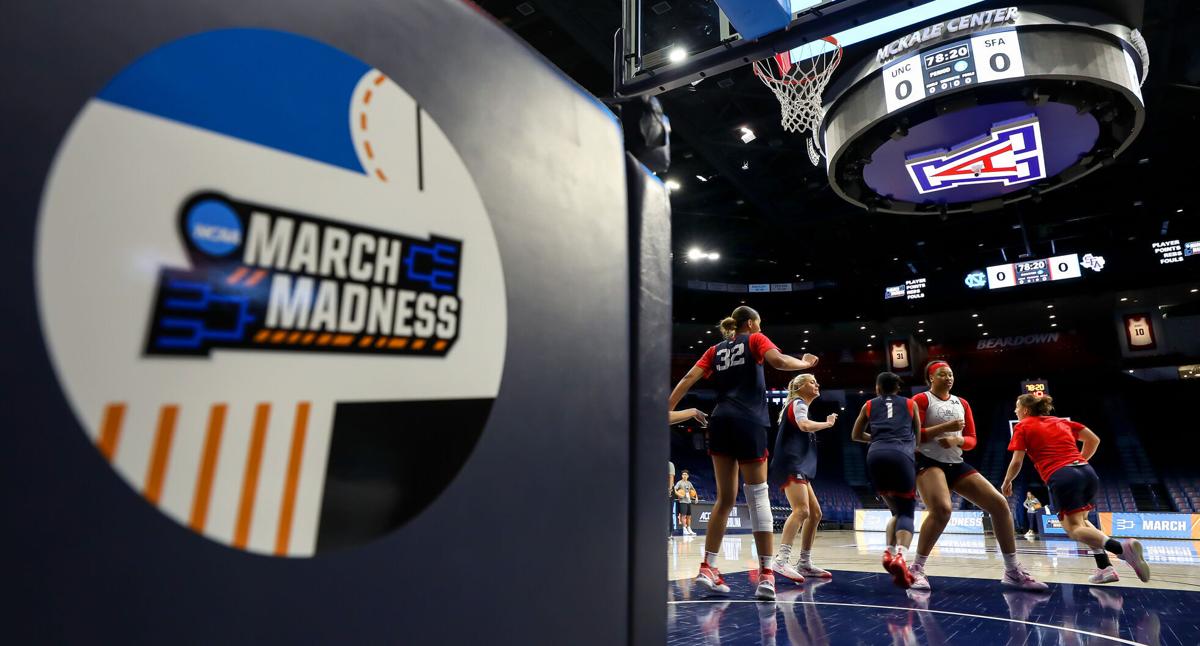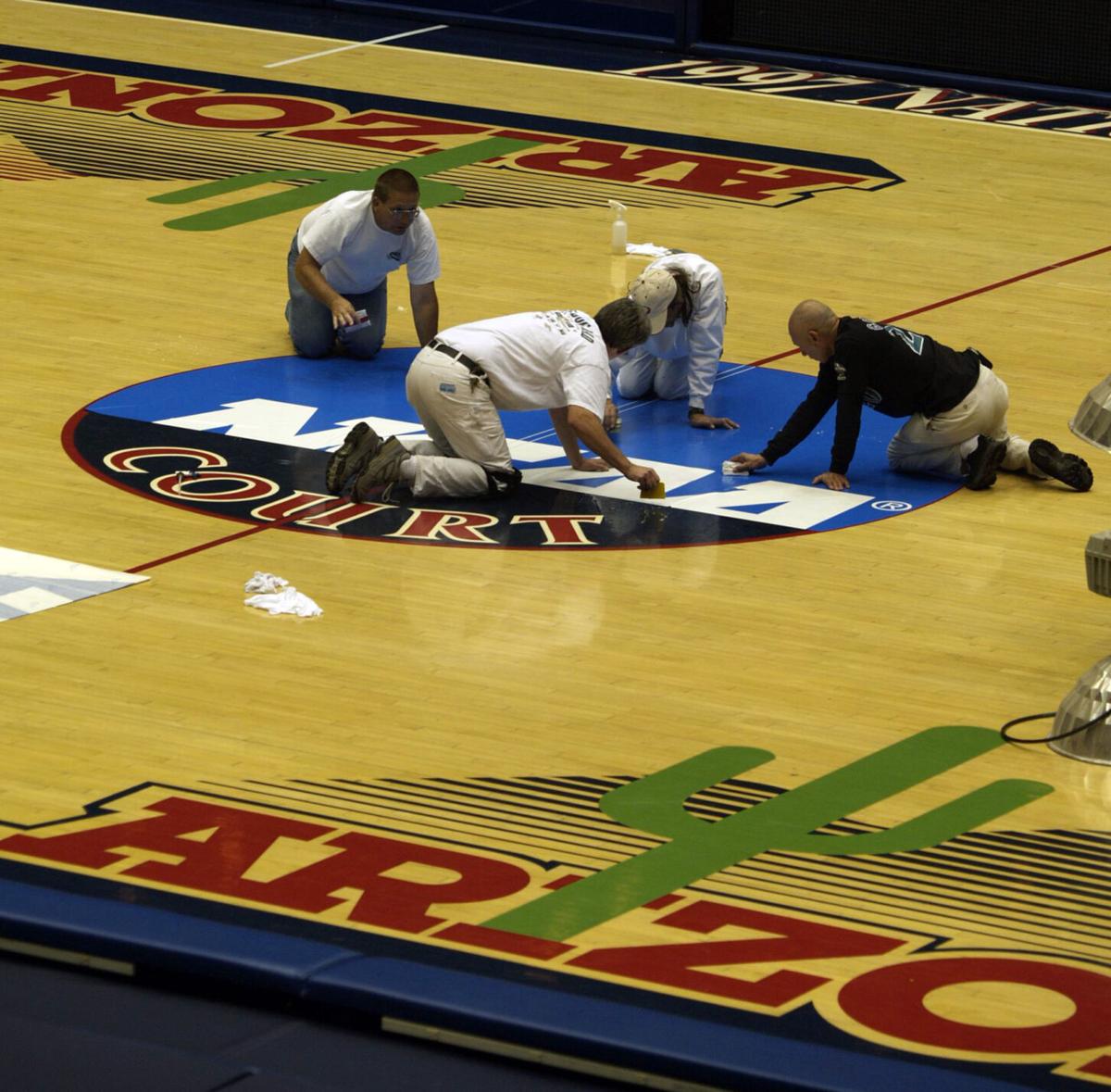The Star's longtime columnist with a plea to have Tucson's McKale Center once again host the NCAA men's tourney, how Pac-12 men's basketball teams have fared in the NCAAs; Arizona's Salt Lake success; and more. When you're done reading Part I, head on over to Part II.
McKale Center long a great NCAA host; it should be again
Arizona's 37 NCAA Men's Basketball Tournament journeys have been a geographic map quest, with trips from coast to coast, some good, some forgettable.
Over the last 40 years, the Wildcats have played first-weekend games in Dayton, Tempe, Albuquerque, Long Beach, Milwaukee, Providence, Sacramento, Boise and even Washington, D.C.
On a scale of 1 to 10, the most juiced first-round site of that period has been Tucson. Yes, McKale Center. In 1987, the NCAA allowed Arizona to play host to UTEP in a first-round game (the Miners won in overtime), and a year later disallowed teams from playing at its home arena.
That didn’t mean McKale Center disappeared. In fact, McKale still ranks seventh in NCAA Tournament history in men's games hosted, 59. It trails only University of Dayton Arena (Dayton, Ohio), 133; Municipal Auditorium (Kansas City, Missouri), 83; Jon M. Huntsman Center (Salt Lake City), 81; Madison Square Garden (New York), 80; Greensboro Coliseum (Greensboro, North Carolina), 69 and the RCA Dome (Indianapolis), 60.
While the Wildcats are back in Salt Lake City this week, the Delta Center is now that city's regular NCAA host, not the University of Utah's on-campus Huntsman Center; that means just three of those (Dayton, MSG, Greensboro) are still in regular rotation as an NCAA Tournament sites.

An Arizona fan purchases tickets on March 18, 2022, ahead of the UA hosting first and second rounds games of the 2022 NCAA Women's Basketball Tournament at McKale Center.
From 1974-2011, Tucson was a coveted spot for NCAA Tournament travelers and teams. Sell-out crowds and sunshine worked.
But after the 2011 tournament, then-UA athletic director Greg Byrne and men's basketball coach Sean Miller — in 2011, just two years into his 12-year Tucson tenure — vowed not to make McKale available to the NCAA for men's tournament games. (The UA did host the first and second rounds of the women's tournament in 2022; the women's bracket still places teams at home arenas of the top 16 seeds, while the men's tournament uses pre-selected neutral sites).
Why? They believed it diminished the potential number of UA fans traveling to the Wildcats' first weekend games.
It was an overreaction, but one that continues.
Let’s hope new Arizona athletic director Desireé Reed-Francois reconsiders and makes McKale available to the NCAA as soon as possible. The positives are strong; It reflects strongly on Tucson as a go-to destination, brings in millions in tourist revenue and gives Tucson a reputation as a basketball town, which has since been replaced in the first-weekend western rotation by Boise and Spokane.
Would you want to travel to Boise or Spokane in March? Me, neither.
Those 59 NCAA games played at McKale have included star power like few in college basketball. John Wooden, Bob Knight, John Thompson, Jerry Tarkanian and Mark Few coached here, Bill Walton, Bill Cartwright, Tim Duncan, David Robinson and Gary Payton played March basketball at McKale.
Let’s do what’s right and bring March Madness back to one of America’s leading basketball towns.
Monson (Don) might’ve prevented Lute’s Arizona years
In the spring of 1982, after Arizona fired basketball coach Fred Snowden, one of the first coaches interviewed by Arizona AD Dave Strack was Idaho coach Don Monson, then one of the game’s rising coaching stars. Monson is the father of Long Beach State coach Dan Monson.
The elder Monson wanted the job. He even called me at the Daily Star office, asking for advice on how to impress Strack. Alas, Strack chose Grand Canyon coach Ben Lindsey, a bust of busts. Lindsey went 4-24 in his only season at Arizona.
After Lindsey was fired after one season, the good news was that new Arizona AD Cedric Dempsey hired Lute Olson away from Iowa. Olson accepted the UA job a week after Monson left Idaho to become the head coach at Oregon in March 1983.
Monson didn’t work out at Oregon. He went 116-145 (66-96 in the Pac-10) in nine years and was fired. Monson, 90, lives in the greater Spokane area.

Purdue center Zach Edey (15) shoots over Arizona's Oumar Ballo (11) and Pelle Larsson in the second half of the Boilermakers' victory over the Wildcats on Dec. 16, 2023, in Indianapolis.
Three stars, three modest backgrounds
The three leading men’s college basketball players this year are probably Purdue’s Zach Edey, Houston’s Jamal Shead and Tennessee’s Dalton Knecht. They are proof that you don’t have to be a coveted 5-star recruit to make a difference in college hoops.
Edey was a 3-star recruit who played his final prep year at the IMG Academy in Florida. The 7-4 Edey narrowed his recruiting wish list to Baylor, Minnesota, Tulane and Western Kentucky. No blueblood gave him a sniff.
Knecht’s story is one of shake-your-head proportions.
The 6-8 forward was not recruited by a Division I school out of Prairie View High School near Denver. He enrolled at Northeastern Junior College in Sterling, Colorado, and played two seasons before being recruited by Northern Colorado. In his two seasons at Northern Colorado, he developed into an All-Big Sky player. In 2022-23, when he played against Tommy Lloyd’s son, Liam, a guard at NAU, Knecht had a pair of double-doubles — 26 points and 13 rebounds followed by a 27-point, 10-rebound game. Yet Arizona did not recruit Knecht, nor did the nearby Colorado Buffaloes.
When Knect entered the transfer portal, he considered Oregon, North Carolina and Kansas.
Shead, a 3-star recruit from the Houston area, had recruiting offers from Colorado State, Drexel, SMU, Texas-Arlington and Texas State before choosing to play for Houston’s Kelvin Sampson. Shead’s development wasn’t immediate. He averaged just 3.2 points as a freshman.
Now Edey, Knect and Shead are household names in college hoops, proof that a roster of 5-and 4-star players isn’t always the best way to go.

UCLA's Tyrus Edney (11) shoots the last-second, game-winning shot over Missouri's Derek Grim in the 1995 NCAA tournament in Boise, Idaho, on March 19, 1995. UCLA won 75-74, and would go on to not only reach the Final Four, but win that year's national championship.
How the Pac-12 men have fared in NCAAs
As the Pac-12 (as we've come to know) enters its final NCAA Men's Basketball Tournament, it’s clear UCLA and Arizona dominated March basketball from 1979-2023. Here’s how the league members fared in the Big Dance in that period:
• UCLA 63-32, five Final Fours
• Arizona, 56-33, four Final Fours
• Utah, 25-19, one Final Four
• Oregon, 21-14, one Final Four
• Stanford, 20-16, one Final Four
• Washington, 14-8
• USC, 13-17
• Cal, 9-14
• Arizona State, 8-12
• Oregon State, 5-10
• Colorado, 4-10
• Washington State, 4-5

Long Beach State head coach Dan Monson shouts toward his players on the McKale Center court during a matchup with Arizona on Nov. 24, 2019, in Tucson.
Monson (Dan) used to Pac-12 bucks at LBSU
In Dan Monson’s 16 seasons as Long Beach State’s basketball coach, he wasn’t afraid to schedule Pac-12 opponents in pre-Christmas games. Monson’s LBSU teams went 6-27 against the Pac-12 in that period.
It wasn’t as bad as the record suggests. Monson and his school agreed to play Pac-12 schools in “guarantee games,’’ meaning Long Beach State would usually be paid from $40,000 to $90,000 to play in Pac-12 arenas.
Only four of those games were played at Long Beach, meaning 29 were in Pac-12 arenas at an average of about $60,000 per game. That’s close to $2 million in revenue for Monson’s school.
Monson’s 49ers beat UCLA in 2010, USC in 2014, Oregon State in 2017 and 2018, Stanford in 2018 and USC this season. They were 0-5 at McKale Center, all against Sean Miller teams, losing by margins of 37, 35, 34, 22 and 15. An average of 28 points per game.
That sounds a bit too high for Thursday’s NCAA opener in Salt Lake City. Let’s say Arizona wins by 22.

Broadcasters Ernest Johnson Jr., Charles Barkley, and Shaquille O'Neal, from left, of "Inside the NBA" smile as they are honored at the 2020 Basketball Hall of Fame awards tip-off celebration and awards gala on May 14, 2021, in Uncasville, Connecticut.
Get used to Shaq and Charles on TV screen
Shaquille O’Neal and Charles Barkley get as much TV time (or more) than most college basketball players in March. Shaq and Charles are regulars in several TV spots, replayed over and over this month.
O’Neal and Barkley were NBA superstars a generation ago and are probably better known today for their roles as NBA TV analysts and accompanying TV spots. It begs the question: How did Shaq and Charles fare in the NCAA Tournament in their college days? Here’s how it went:
• Shaq: He played in the NCAAs in 1990, 1991 and 1992. His LSU Tigers went 2-3 in that period, never advancing beyond the Round of 32. The Tigers were never seeded higher than No. 5. But Shaq was prolific. He had a 26-point, 11-rebound, 11-block triple-double against BYU in 1992. He also scored 36 points in a loss to Indiana that season. In five NCAA games, Shaq averaged 24 points and 11.8 rebounds.
• Barkley: His Auburn teams of ’82 and ’83 did not qualify for the NCAA Tournament. His ’84 Auburn team, a No. 5 seed, lost its opener to Richmond, 72-71. Barkley had a double-double, 23 points and 17 rebounds.

Arizona's Andre Iguodala and Chris Rodgers fall on a happy Luke Walton at the end of double overtime as the Wildcats defeated Gonzaga, 96-95, on March 22, 2003, in Salt Lake City to advance to the Sweet 16 of the 2003 NCAA Men's Basketball Tournament Tournament.
Salt Lake has been good to Wildcats
Arizona has played more NCAA Tournament games in Salt Lake City, 11, than any other location. The Wildcats are 9-2, going 5-2 at Utah’s Huntsman Center and 4-0 at the Utah Jazz’s downtown arena.
Best memory: A double-overtime victory over Gonzaga in a Round of 32 game in 2003, when the No. 1-seeded Wildcats needed a game-tying shot from Luke Walton to force a second overtime, and a missed buzzer shot in the second OT by Gonzaga’s Blake Stepp at the buzzer in a 96-95 win.
Worst Memory: No contest. The No. 2 seed Wildcats lost to Steve Nash and Santa Clara on the Utah campus in a 1993 game, 64-61, as the Pac-10 player of the year, Chris Mills, was limited to nine minutes in the second half with foul trouble. Arizona shot a season-low 30.9% from the field.
Best individual game by any Wildcat in SLC: In a 1991 win over BYU, with most of the 14,369 fans cheering for the Cougars, UA power forward Brian Williams had a 21-point, 14-rebound performance against BYU’s 7-6 Shawn Bradley, who was limited to 10 points.
All of the emotion and excitement of the 1997 NCAA tournament set to the tune of "One Shining Moment." One Shining Moment, words and music © 1986 David Barrett, (p) 1986-2000 David Barrett. (March Madness YouTube)











